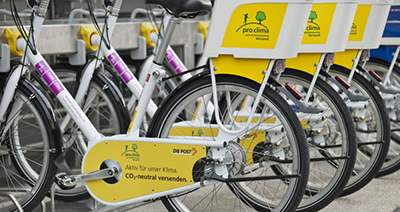
The transport sector is a main contributor to energy consumption in developed countries. Therefore, less energy-intensive forms of mobility are critical for the success of energy consumption reduction strategies. Shared mobility modes, i.e. carsharing, bike-sharing, car-pooling, are finding growing appreciation among the public, and are also increasingly present in the discourse about the reduction of negative transportation externalities. Intuitively, this makes sense – several studies document such benefits – but little is known on how such systems fit together, especially if they grow in size. This question is being tackled by a project called «Sharing is Saving», which just started at the Institute for Transport Planning and Systems (IVT) and is being financed by the Swiss National Science Foundation (SNF).
This project plans to evaluate the opportunities offered by the recent success of shared vehicle systems in order to rethink the current transportation system, largely based on private cars, and move toward more sustainable and less energy-intensive forms of mobility. It is funded by the SNF as part of their Energy Strategy 2050, which aims at developing new technologies in order to substantially reduce energy consumption in Switzerland by 2050. The main question is: can the further diffusion of these new technologies actually reduce the impact of mobility on energy consumption and how? The core of the project is investigating how the selected shared modes should be combined in order to obtain a reduction in energy consumption, while keeping an eye on possible trade-offs for society.
This will be investigated using MATSim, an agent-based transport simulation software developed at IVT. First, several hypothetical scenarios, representing different combinations and availability levels of collaborative mobility options, will be generated and evaluated in terms of cost and benefits for the society. Second, to give more substance to the simulation results, another part of the project would be to find out how acceptable the different simulated scenarios would be for the public. This will be done through a specially designed survey administered to a representative sample of the population. The results will be used to evaluate various behavioural models, which will be then implemented in the simulation. This will enhance its realism and improve the final answer on what can be achieved in terms of reducing energy consumption and other externalities with a large-scale, combined use of various innovative mobility concepts.
In summary, our work will produce new knowledge about the possible impact of collaborative mobility on the transportation system and society. The results should provide an insight into how collaborative mobility modes could be integrated and if and how they will indeed reduce the energy footprint of transportation. This will help policy makers understand the risks and the chances coming with the further diffusion of such modes and operators of this sector creating new development strategies.
Francesco Ciari is scientific collaborator at the Group Transport Planning (Prof. Kay W. Axhausen), IVT, ETH Zurich.